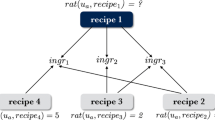Abstract
In this paper, we propose a context-aware food recommendation system for well-being care applications. The proposed system, called u-BabSang, provides individualized food recommendation lists at the dining table, and is based dietary advice in the typical Korean medical text. Our proposed system receives a user’s profile, physiological signals, and environmental information around the dining table in real time. To operate our system, we present a method for user specified analysis, and also describe time-division layered context integration which integrates the multiple contexts obtained from the sensors. Thus, our system recommends appropriate foods for each individual’s health at the table in real time.
Similar content being viewed by others
References
Bruno F, Alois S (2001) Happiness and economics: how the economy and institutions affect well-being. Princeton University Press, Princeton
Michael S, Charles C (1992) Effects of optimism on psychological and physical well-being: theoretical overview and empirical update. Cogn Ther Res 16(2):201–228
Dennerstein L, Smith AM, Morse C (1994) Psychological well-being, mid-life and the menopause. Maturitas 20(1):1–11
Toshiyo T, Tatsuo T, Mitsuhiro O, Mikiko Y (1998) Fully automated health monitoring system in the home. Med Eng Phys 20(8):573–579
Han C, Inkyoon L, Soojin L, Sonhae C, Hyunsu B, Moochang H, Minkyu S (2003) An alternative way to individualized medicine: psychological and physical traits of Sasang typology. J Altern Complement Med 9(4):519–528
Jun H (1999) Donguibogam. Rubin Publishers, New York
Zhenzhen Z (1998) Do-it-yourself Chinese medicine: the hot & cold food cure. Nat Health 27(1):90
Jim K, Raymond R (2004) Nutritional genomics: the next frontier in the postgenomic era. Physiol Genomics 16:166–177
Cherlho L (2007) Harmonization of eastern and western health knowledge; nutrigenetics and Sasang typology. Food Sci Technol Res 13(2):89–95
Christopher LR, Sean C, Janice K, Frederick M, Yongmin K III (2002) Asynchronous web-based patient-centered home telemedicine system. IEEE Trans Biomed Eng 49(12):1452–1462
Sung M, Marci C, Pentland A (2005) Wearable feedback systems for rehabilitation. J Neuroeng Rehabil 2:17
Sensewear, BodyMedia Inc (2008) http://www.bodymedia.com/pnt_over.asp/. Accessed May 2008
Nike + iPod, Apple Inc (2008) http://www.apple.com/ipod/nike/. Accessed as of May 2008
Nuria O, Fernando FM (2006) MPTrain: a mobile, music and physiology-based personal trainer. In: Proceedings of the 8th conference on human-computer interaction with mobile devices and services (MobileHCI 2006), Helsinki, Finland, September 2006. ACM Press, New York, pp 21–28
Kenghao C, Shihyen L, Haohua C, Jane H, Cheryl C, Tungyun L, Chiehyu C, Polly H (2006) The diet-aware dining table: observing dietary behaviors over a tabletop surface. In: Proceedings of pervasive 2006. LNCS, vol 3968. Springer, Berlin, pp 365–382
Oliver A, Mathias S, Paul L, Gerhard T (2005) Analysis of chewing sounds for dietary monitoring. In: Proceedings of Ubicomp 2005. LNCS, vol 3660. Springer, Berlin, pp 56–72
Jennifer M, Gary H, Hochak H, Sharon L, Elizabeth N (2002) Using low-cost sensing to support nutritional awareness. In: Proceedings of Ubicomp 2002. LNCS, vol 2498. Springer, Berlin, pp 371–376
Dongpyo H, Hedda S, Woontack W (2007) Linking context modeling and contextual reasoning. In: Kofod-Petersen A, Cassens J, Leake DB, Schulz S (eds) Proceedings of the 4th international workshop on modeling and reasoning in context (MRC2007), pp 37–48
Jess, Sandia National Laboratories (2008) http://herzberg.ca.sandia.gov/. Accessed May 2008
CLIPS, Sourceforge.net (2008) http://clipsrules.sourceforge.net/. Accessed May 2008
Weight Function, Wikipedia (2008) http://en.wikipedia.org/wiki/Weight_function/. Accessed June 2008
Particle, TECO (2008) http://particle.teco.edu/. Accessed May 2008
Author information
Authors and Affiliations
Corresponding author
Rights and permissions
About this article
Cite this article
Oh, Y., Choi, A. & Woo, W. u-BabSang: a context-aware food recommendation system. J Supercomput 54, 61–81 (2010). https://doi.org/10.1007/s11227-009-0314-5
Received:
Accepted:
Published:
Issue Date:
DOI: https://doi.org/10.1007/s11227-009-0314-5




